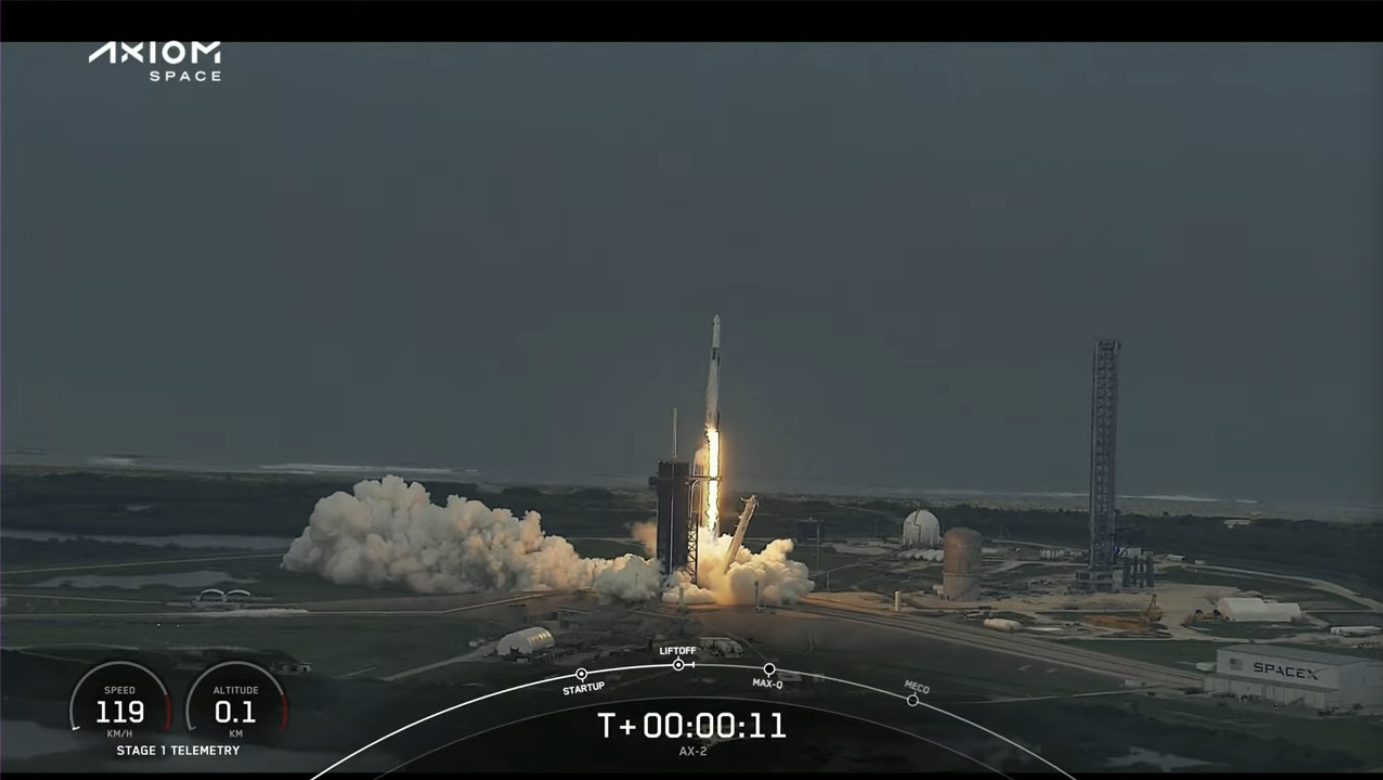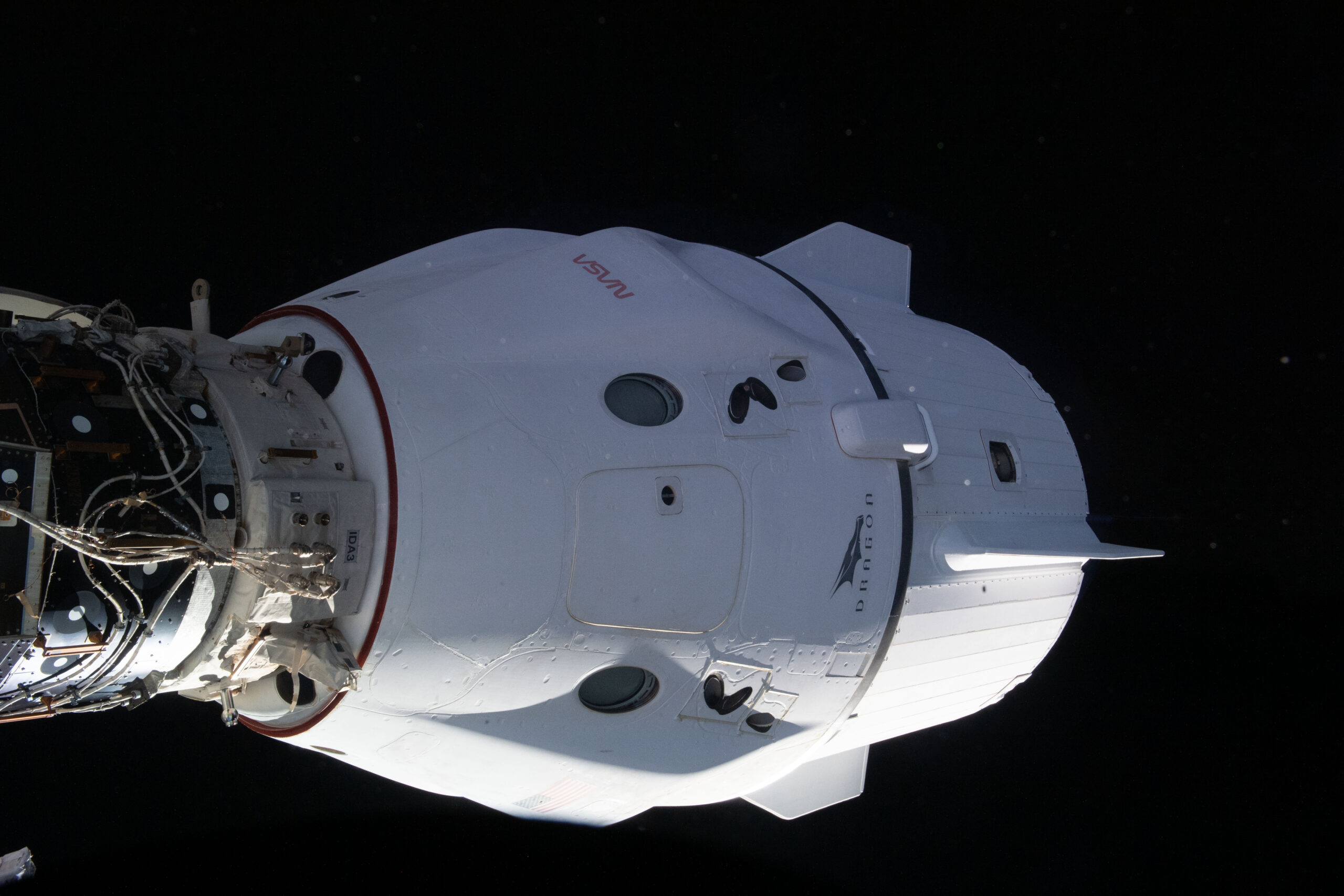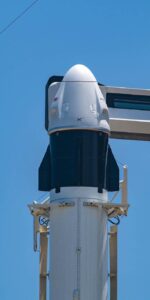
Four men and women from two nations—including the first Saudi woman astronaut and America’s most flight-seasoned space traveler—are en-route to the International Space Station (ISS) tonight, following Sunday’s 5:37 p.m. EDT liftoff of Dragon Freedom on the ten-day Ax-2 scientific research and educational outreach mission, flying on behalf of Houston, Texas-based AxiomSpace, Inc. The first-time-flown B1080 Falcon 9 booster roared aloft from historic Pad 39A at Florida’s Kennedy Space Center (KSC), carrying Ax-2 Commander Peggy Whitson, Pilot John Shoffner and Mission Specialists Ali Al-Qarni and Rayyanah Barnawi on a 16-hour trek to reach their orbital home early Monday.

B1080, the third brand-new “single-stick” Falcon 9 to have entered SpaceX’s burgeoning fleet so far in 2023, rolled out to the pad on Thursday and completed a Static Fire Test of her nine Merlin 1D+ engines on Friday. Early Saturday, Whitson, Shoffer, Al-Qarni and Barnawi awakened, breakfasted and donned their customized SpaceX launch and entry suits, before taking the well-driven route from the Neil Armstrong Operations & Checkout Building to Pad 39A aboard Tesla Model X Crew Transport Vehicles.

At the historic pad—whose 158 prior launches included the first humans to orbit the Moon, the first crewed lunar landing, the Skylab space station and the first shuttle flight—the four astronauts ascended the elevator and were assisted into their seats aboard Dragon Freedom. This particular ship was gearing up for her second orbital voyage after supporting the 170-day Crew-4 increment to the ISS last year.

Commanding tonight’s mission, Whitson already holds multiple records. She is the United States’ most flight-experienced astronaut—with over 665 days across her three previous missions—as well as being the world’s most experienced female spacewalker, the first female chief of NASA’s Astronaut Corps and the first female space station commander.
Piloting Dragon Freedom tonight is veteran airshow pilot, athlete and motorsports endurance racer John Shoffner, with Royal Saudi Air Force (RSAF) Capt. Ali Al-Qarni and biomedical research scientist Rayyanah Barnawi of Saudi Arabia rounding out the quartet as Mission Specialists. As soon as Ax-2 achieved orbit, Barnawi became the first Saudi woman to enter space and Whitson became the first woman to command a Commercial Crew flight. Al-Qarni is the second Saudi male astronaut, following in the footsteps of Prince Sultan Salman Abdul Aziz Al-Saud, who flew on shuttle Discovery in June 1985.

With weather conditions along the Space Coast trending around 60-percent-favorable, and with a sharp deterioration expected early next week, launch teams completed a sterling effort to get Ax-2 airborne at 5:37 p.m. EDT Sunday. Shortly before T-13 minutes, Whitson was notified that an anvil cloud had been observed nearing Pad 39A at a distance of 5 miles (8 kilometers). “Thinking dry thoughts,” she quipped.
SpaceX added that the cloud had to be at least 3 miles (4.8 kilometers) from the pad in order for launch to proceed. By T-2 minutes, the last weather concern was cleared.

And at T-45 seconds, the Launch Director issued a final “Go for Launch”. Replied Whitson: “Dragon copies, Go for Launch.”
B1080 powered the 230-foot-tall (70-meter) Falcon 9 uphill for the first 2.5 minutes of the flight, before separating from the stack and descending to a picture-perfect touchdown on solid ground at Landing Zone (LZ)-1 at Cape Canaveral Space Force Station. Touchdown occurred at seven minutes and 45 seconds past liftoff.

It marked the first time that a crew-carrying Falcon 9 core has executed a Return to Launch Site (RTLS) maneuver, with an expectation that the Crew-7 booster in mid-August will do likewise. According to SpaceX Vice President of Build and Flight Reliability Bill Gerstenmaier, performing such RTLS maneuvers on this and future crewed launches is expected to furnish “a little bit of extra Falcon performance”.
With B1080 gone, the single Merlin 1D+ Vacuum engine of the second stage burned for about six minutes to lift Dragon Freedom into orbit. The spacecraft separated from the booster a little less than 12 minutes after launch, followed a minute or so later by the opening of its nose cone to expose its rendezvous sensors and docking apparatus.

Current plans are for Dragon Freedom to autonomously dock at the space-facing (or “zenith”) port of the station’s Harmony node at about 9:24 a.m. EDT Monday, just shy of 16 hours after launch. This port was vacated by Dragon Endeavour earlier in May, in readiness for both Ax-2’s arrival and the subsequent arrival in early June of the research-laden CRS-28 Cargo Dragon mission.
And it is the forthcoming arrival of CRS-28 for its month-long research stay that Ax-2 has been shortened in duration from an original mission design of 12 days, including ten docked at the ISS, to ten days, with eight docked at the ISS. The shortened duration will prioritize Ax-2’s complement of scientific payloads, with several lower-priority activities (including some media events) deleted from the timeline.

On-orbit, the station’s incumbent Expedition 69 crew—Commander Sergei Prokopyev and fellow Russian cosmonauts Dmitri Petelin and Andrei Fedyayev, U.S. astronauts Frank Rubio, Steve Bowen and Warren “Woody” Hoburg and Sultan Al-Neyadi of the United Arab Emirates (UAE)—has busily been preparing for Ax-2’s arrival. Last week, Bowen gathered and staged emergency hardware to accommodate the new arrivals and Al-Neyadi reviewed procedures and set up computers in the multi-windowed cupola and the U.S. Destiny lab to support Dragon Freedom’s inbound approach and docking.
Ahead for Ax-2 are more than 20 multidisciplinary experiments spanning the life sciences, human research, physical sciences and technology demonstrations. Additionally, the mission carries Science, Technology, Engineering, Arts and Mathematics (STEAM) outreach investigations and Whitson’s crew will support about 130 cumulative hours of National Lab Science during their week aboard the sprawling orbital outpost.

Key technology demonstrations aboard Ax-2 include sensors to detect odors in the ISS pressurized environment, an experimental mobile communications device, a wireless transfer application to automatically downlink imagery, a smart stowage and inventory management video system and an intravehicular “skin-suit”, worn by the astronauts, to simulate several aspects of terrestrial gravity and mitigate negative factors such as spinal elongation, muscle atrophy and sensorimotor changes.
In the physical sciences arena, Ax-2 will examine concepts of “cloud seeding”—the artificial inducement of rainfall by implantation of silver iodide crystals in clouds—in the microgravity environment. This experiment will mix moist air and silver iodide crystals in a reaction chamber as part of efforts to develop weather-control technologies for future human settlements on the Moon and Mars.
Other investigations will test a new hydrogen-rich polymer in the ISS internal radiation environment to assess its shielding capabilities and Ax-2 astronauts will also acquire imagery through the windows of the station’s cupola to study lightning and other atmospheric phenomena, including sprites, blue jets and elves. This experiment will also engage students in the Middle East, Africa, Asia and the Americas.
Further emphasizing the STEAM-focus of Ax-2, the mission may also include usage of the Amateur Radio on the ISS (ARISS) hardware to facilitate ham radio contact with students in classrooms or public forums around the world. And Saudi students will participate in experiments looking at the aerodynamic behavior of different-shaped kits on the space station, performing their own ground-based activities in tandem.

In the life sciences, Ax-2 will optimize the assembly of DNA-based nanomaterials for potential therapeutic use, investigate the effect of the microgravity environment upon the production of stem cells and derived products, explore the inflammatory response of human immune cells, conduct cancer research and examine bioengineered liver and kidney tissue constructs. The Translational Research Institute for Space Health (TRISH), a partnership between NASA’s Human Research Program (HRP) and an academic consortium including Baylor College of Medicine in Houston, Texas, the California Institute of Technology in Pasadena, Calif., and Massachusetts Institute of Technology in Cambridge, Mass., has also provided a battery of tests, physical assessments, questionnaires, biological sampling sessions and wearable devices to monitor the Ax-2 crew’s adaptation to microgravity and their capacity to perform cognitively demanding work.
Whitson’s association with Ax-2 first entered the public consciousness in January 2021, when she was assigned to back up former shuttle astronaut and veteran ISS commander Mike Lopez-Alegria in his command of Ax-1, the first all-private mission to the station. Having retired from NASA’s Astronaut Corps in June 2018, Whitson joined AxiomSpace, where she now serves as its head of human spaceflight.

“Not the first time I have backed up @CommanderMLA,” Whitson tweeted at the time, harking back to her 2006-2007 stint as backup to Lopez-Alegria’s Expedition 14 mission. “The next best thing to flying in space is training for it.”
Late in the spring of 2021, she and Shoffner were assigned to Ax-2 and NASA and AxiomSpace formally signed the mission order the following December, with an expectation that the flight would take place in late 2022 or early 2023. In its mission order, NASA noted that Ax-2 is also charged with bringing home scientific samples “that must be kept cold in transit back to Earth”, as well as a Nitrogen/Oxygen Recharge System (NORS) tank, potentially two late-return cargo transfer bags and will include “up to ten hours of the private astronaut mission commander’s time during the docked mission to complete NASA science or perform tasks for NASA”.
By last August—with the 17-day Ax-1 mission having triumphantly flown last April—Ax-2’s launch date was shifted slightly to the second quarter of 2023. Last September, AxiomSpace contracted with the Saudi Space Commission (SSC) to fly Saudi Arabia’s second male and first female astronauts to the ISS “no earlier than 2023”. With Ax-2 having attained formal approval from NASA and its International Partners (IPs) last January, the announcement of Al-Qarni and Barnawi finally came in mid-February.
The Ax-2 are also carrying several personal items with them into space. Whitson is flying with her wedding necklace, as she did on her three previous ISS-bound missions, whilst Shoffner is taking a toy spaceman from a Gemini spacecraft he built as a child. Also aboard Dragon Freedom are Barnawi’s grandmother’s 60-year-old earrings and packets of Saudi coffee and dates, courtesy of Al-Qarni.






9 Comments
9 Pings & Trackbacks
Pingback:Ax-2 Mission Concludes, Targets Tuesday Departure, Splashdown - AmericaSpace
Pingback:SpaceX Aims for Monday Launch Double-Header - AmericaSpace
Pingback:SpaceX, ULA Launch Missions, 119 Minutes Apart - AmericaSpace
Pingback:SpaceX Launches Euclid to Probe the “Dark” Universe - AmericaSpace
Pingback:SpaceX Launches 16x-Flown Falcon 9, After 48-Hour Delay, Unexpected Static Fire Test - AmericaSpace
Pingback:Crew-7 Launches, Four Nations En-Route to Space Station - AmericaSpace
Pingback:SpaceX Heads for Record-Setting Year, Launches 250th Successful Falcon 9 Mission - AmericaSpace
Pingback:SpaceX, ULA Target Thursday Pre-Dawn Launches, Six Minutes Apart - AmericaSpace - Digi90
Pingback:SpaceX Looks to Saturday Falcon 9 Double-Header - AmericaSpace